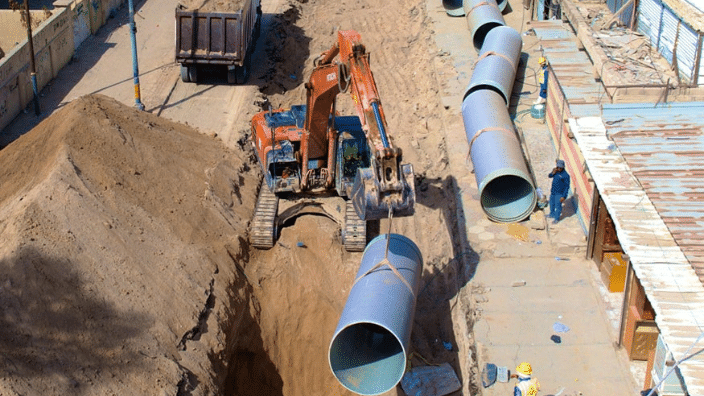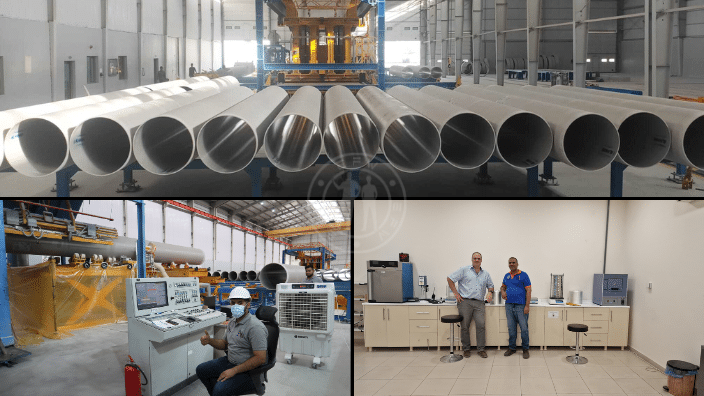Myths vs. reality
When it comes to GRP (Glass Reinforced Plastic) pipes, myths often overshadow the reality of their capabilities. As the industry evolves, misconceptions persist, influencing decisions and delaying potential improvements. Whether you’re new to GRP or looking to optimize your current systems, it’s crucial to break down the myths that could be keeping you from making the best choice.
Let’s take a closer look at three of the most common myths about GRP pipes—and what the real story is behind each one.
Myth 1: GRP Pipes Are Not As Durable As Steel or Concrete
There’s a persistent belief that GRP pipes can’t compete with traditional materials like steel or concrete when it comes to durability. This myth comes from outdated assumptions and a lack of understanding of how modern composite materials, like GRP, actually perform in real-world conditions.
The truth? GRP pipes are built to withstand extreme environments that would compromise steel or concrete. Their composition – fiberglass and resin – gives them exceptional resistance to corrosion, abrasion, and chemicals, making them ideal for industries like wastewater, marine, and chemical processing.
Steel pipes rust when exposed to water and chemicals, and concrete pipes crack under environmental stress. On the other hand, GRP pipes remain unaffected by these conditions, extending their lifespan significantly. In fact, GRP’s resistance to microbial corrosion and electrochemical reactions sets it apart as a superior choice for long-term durability.

Myth 2: GRP Pipes Are More Expensive Than Other Options
It’s easy to assume that GRP pipes are more expensive upfront than their metal and concrete counterparts. After all, the initial cost often seems higher.
But here’s the reality: When you factor in the full lifecycle, GRP pipes offer far more value than the competition. Let’s break it down:
1. Maintenance and Longevity: GRP pipes require minimal maintenance. Unlike steel pipes that need constant monitoring for rust or concrete pipes that crack over time, GRP’s corrosion resistance significantly reduces repair and replacement costs. Once installed, they can last decades without requiring major upkeep.
2. Installation Costs: GRP pipes are significantly lighter than steel or concrete, which translates into lower transportation and handling costs. Additionally, GRP pipes are easier and faster to install—requiring fewer labor hours, less heavy equipment, and shorter project timelines. This leads to reduced overall project costs, including transportation, labor, and installation expenses.
3. Cost Efficiency Over Time: While the initial investment might be higher, the long-term savings in maintenance, installation, and operational efficiency more than offset the upfront cost. GRP pipes deliver superior value by lowering your overall total cost of ownership.

Myth 3: GRP Pipes Are Hard to Customize and Install
There’s a popular myth out there that Glass Reinforced Plastic (GRP) pipes are tougher to customize and install than traditional materials like metal and concrete. This misconception likely stems from the early days of composite materials or simply a lack of familiarity with modern GRP technologies, like Effective Filament Winding (EFW®).
The truth? GRP pipes are highly adaptable and, thanks to advancements in manufacturing, are actually easier to customize and install than ever before. With the right tools and expertise, GRP pipes can be tailored to fit any specific project needs, making them an ideal choice for a variety of applications—from wastewater systems to complex chemical processing facilities. This completely busts the myth that GRP pipes are a hassle to work with.
Customization through EFW® Technology
One of the significant advantages of GRP pipes is their customizability, which is greatly enhanced by EFW® technology. This state-of-the-art process allows manufacturers to precisely control every aspect of the pipe manufacturing process, from the resin formula to the thickness and angle of the fiberglass layers. EFW® technology uses automated controls to ensure that each pipe meets exact specifications, which can be adjusted according to the unique chemical, physical, and environmental demands of any project.
For instance, for projects that require pipes for special application, EFW® can adjust the materials and/or the design to achieve the project needs. This level of precision ensures that GRP pipes are not only as customizable as metal or concrete pipes but offer even greater specificity to meet project needs.
Are you still hesitating to switch to GRP pipes based on outdated myths and misconceptions? Let’s set the record straight together. Dive deeper into the true potential of GRP pipe technology and see for yourself how it surpasses traditional materials in durability, cost-efficiency, and ease of installation. Whether you’re dealing with harsh environments, special environments or looking for long-term savings, or need versatile solutions for complex installations, GRP pipes equipped with Effective Filament Winding technology are designed to meet and exceed your expectations.
Join us for a comprehensive, no-cost consultation where we’ll debunk these myths in detail.
Our experts are ready to provide insights and real-world examples demonstrating how GRP pipes have successfully transformed projects just like yours. We will show you how their exceptional corrosion resistance can reduce maintenance costs and extend the lifecycle of your infrastructure, how their lightweight nature can lower both transportation and installation costs, and how their customizability makes them an ideal choice for a variety of applications.
This consultation is more than just a conversation; it’s a step towards optimizing your resources and enhancing the efficiency of your operations. We will also discuss how the precision of our EFW® technology can specifically tailor GRP pipe solutions to meet the unique challenges of your projects, ensuring you get the most out of your investment.
Don’t let misconceptions hold you back. Embrace innovation and see how modern solutions can drive your projects forward. Whether you’re planning a new installation or looking to upgrade your existing infrastructure, our expert guidance will help you make informed decisions that align with your business objectives and operational needs.
Click here to book your comprehensive consultation and start transforming your project with GRP pipe solutions today!
This is your opportunity to explore the advantages of GRP pipes first-hand and understand why they are the smarter choice for your construction needs. Equip your projects with the technology that promises not only to meet but exceed your rigorous demands. Act now—your journey towards more effective, efficient, and economical construction solutions begins here.

